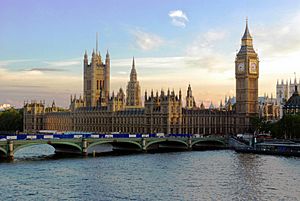Edward Hopkins facts for kids
Quick facts for kids
Edward Hopkins
|
|
|---|---|
| 2nd Governor of the Colony of Connecticut | |
| In office 1640 – 1655 (7 separate terms) |
|
| Member of Parliament for Dartmouth |
|
| In office 1656–1657 |
|
| Personal details | |
| Born | 1600 Shrewsbury, Shropshire, England |
| Died | March 1657 (aged 56–57) London |
| Signature | |
Edward Hopkins (born 1600 – died March 1657) was an important English colonist and politician. He was the second Governor of the Connecticut Colony. He worked in both England and America.
Hopkins helped start the New Haven and Connecticut colonies. He served seven times as the Governor of Connecticut. In the 1650s, he went back to England. There, he worked for Oliver Cromwell's government. He was a Lord Commissioner of the Admiralty (a high naval official) and a member of Parliament. Even though he was in England, he was elected Governor of Connecticut again in 1655. He died in London in 1657.
After he died, Hopkins left a lot of money in a special fund called a "trust." This money was meant to help young people get an education in the colonies. It was for "breeding up of Hopefull youth in the way of Learning both at ye Gramar School & Colledge." This was to help the country and spread Christian teachings.
However, the laws about trusts in America were new back then. So, The Charity of Edward Hopkins (as it's known today) was stuck in legal battles for 135 years! Eventually, the case was settled. Harvard College became the main beneficiary. The Hopkins School in New Haven, Connecticut and other schools also received money.
Because of this trust, the town of Hopkinton, Massachusetts was named after him. Harvard College bought 12,500 acres of land there using money from Governor Hopkins's fund.
Contents
Who Was Edward Hopkins?

Edward Hopkins was born in 1600 in Shrewsbury, Shropshire, England. He went to Shrewsbury School. Later, he moved to London and became a successful merchant. He traded goods with countries in the Near East. His uncle, Sir Henry Lello, might have helped him. His uncle was an English Ambassador and held other important jobs.
Edward Hopkins married Ann Yale around 1636 or 1637. Ann was the daughter of David and Ann Yale. Her stepfather was Theophilus Eaton, who became an important figure in the colonies.
How Did Edward Hopkins Get Involved in the Colonies?
Hopkins became involved in plans to start a colony on the coast of Long Island Sound. This effort was led by Lord Say and Sele and Baron Brooke. Hopkins helped get supplies for the first trip in 1635. This trip was led by Lion Gardiner. Later, rules made it harder for people to move to New England. So, the people behind the project mostly gave up.
In 1637, Hopkins joined a new group. This group was led by Theophilus Eaton (his wife's stepfather) and John Davenport. They started a settlement at the mouth of the Quinnipiac River. This became the New Haven Colony.
Two months later, Hopkins went north to Hartford. Hartford was a new settlement on the Connecticut River. He was supposed to buy more land for the New Haven colonists. But he decided to stay in Hartford instead. He became one of the first settlers of the Connecticut Colony.
Edward Hopkins as Governor
In 1639, the Connecticut Colony held its first election. Hopkins became one of the "Assistants" to the government, called the General Court. Then, in 1640, Hopkins was elected Governor.
The colony's rules said that a governor could not be re-elected right away. So, Hopkins and John Haynes (Connecticut's first Governor) took turns being governor. When one was governor, the other was the Deputy Governor. This continued from 1639 to 1655.
In 1646, Hopkins survived an attack by a Native American tribe. They were angry because Connecticut protected the chief of a rival tribe. Hopkins supported the New England Confederation, which was a group of colonies working together. He was one of its leaders.
Hopkins invested a lot in the colony. He also made money by bringing supplies from Europe. He even had a monopoly on the local fur trade.
In 1650, he helped negotiate the Treaty of Hartford. This treaty set the borders between the English colonies and the Dutch colony of New Netherland. The Dutch leader was Peter Stuyvesant.
Edward Hopkins's Later Life in England
Hopkins went back to England several times while he was still governor. Oliver Cromwell appointed him to important roles. First, he became a Commissioner of the Royal Navy. Later, he was made a Lord Commissioner of the Admiralty. This meant he helped manage the English navy.
He also oversaw the printing of the New Haven Colony's first laws. He served in the English Parliament during Cromwell's time.
In 1655, Connecticut residents elected Hopkins as Governor one last time. They hoped to bring their respected governor back. But he did not return to America. The Deputy Governor, Thomas Welles, served out Hopkins's last term. Edward Hopkins died in March 1657 in London.
What Is Edward Hopkins's Legacy?
Money from Edward Hopkins's will helped create the Hopkins School in New Haven, Connecticut. This was also a wish of John Davenport, who founded the New Haven colony.
Also, the Hopkins Classical School in Cambridge, Massachusetts and Hopkins Academy were started with money from his estate. As mentioned before, Hopkinton, Massachusetts, was named after him. This town was built on land bought with funds from his charity.

